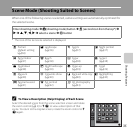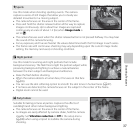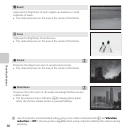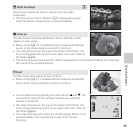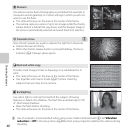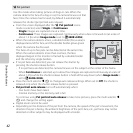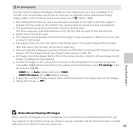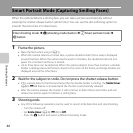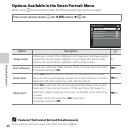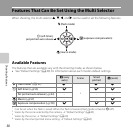
43
Shooting Features
s 3D photography
Use this mode for taking 3D images viewable in three dimensions on a 3D-compatible TV or
monitor. The camera takes one picture for each eye to simulate a three-dimensional image.
Images taken in this mode are saved at an image size of n (1920 × 1080).
• After taking the first picture, move the camera horizontally to the right so that the subject is
aligned with the guide on the monitor. The camera takes the second picture automatically.
• The camera focuses at the center of the frame for the first shot.
The focus, exposure, and white balance set for the first shot are used for the second shot.
• Digital zoom cannot be used.
• The telephoto zoom position is limited to the angle of view equivalent to that of a 132 mm lens
in 35mm [135] format.
• The angle of view (i.e., the area visible in the frame) seen in the saved image will be narrower
than that seen in the monitor at the time of shooting.
• The two captured images are saved as a 3D picture (MPO file) consisting of the left and right eye
images. The first image (the left eye image) is also saved as a JPEG file.
• 3D images cannot be played back in 3D on the camera monitor. Only the left eye image of a 3D
image is displayed during playback.
• To view 3D images in 3D, connect the camera to a 3D-compatible TV or monitor using a 3D-
compatible HDMI cable and configure the camera as described below using TV settings in the
setup menu (A88).
- HDMI: Set to Auto (default setting) or 1080i.
- HDMI 3D output: Set to On (default setting).
• It may take a while to display images when switching between 3D images and non-3D images.
• Taking 3D Pictures ➝ E5
B Notes About Viewing 3D images
When viewing 3D images on a 3D-compatible TV or monitor for an extended period of time, you
may experience discomfort such as eye strain or nausea. Carefully read the documentation included
with your TV or monitor to ensure proper use.



